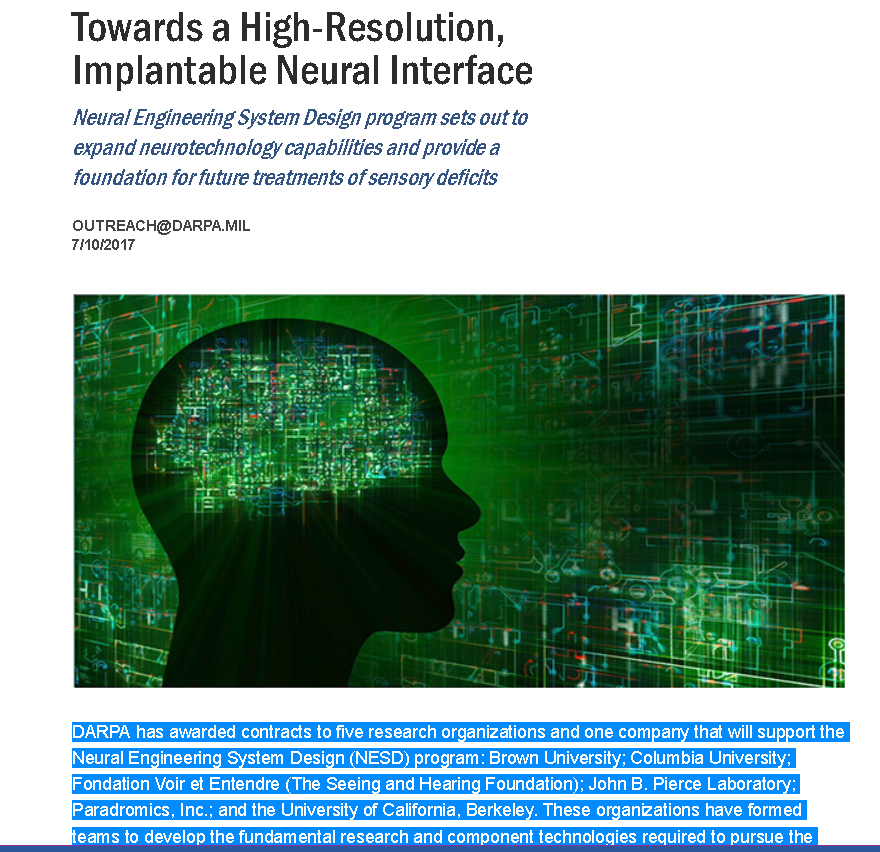
Brain-to-Computer Signal Processing
DARPA’s Neural Engineering System Design (NESD) program conducts research with advanced neural interfaces that provide high signal resolution, speed, and volume data transfer between the brain and electronics.
The program is very comprehensive, spanning numerous disciplines, including neuroscience, low-power electronics, photonics, medical device manufacturing, systems engineering, and clinical testing.
How it Works
Using biochips and sensors, researchers transcode high-definition sensory information. This requires advanced mathematical and neuro-computation techniques between electronic and cortical neuron representations.
The brain-to-computer interfaces convert electrochemical brainwave ‘language.’ Researchers can then collect brain data (literally read, write, and interact with the brain’s neural system). The technology makes it possible to interact with any biological process, including vision, hearing, and speech.

Biochip Implants
Commercially available wireless biochip sensors have surpassed any fantasy science fiction story. The technologies available now are not only small enough to be inserted via painless injection (200μm × 200μm × 100μm), they can be manufactured to an incredibly small nanoscale level that cannot be detected by your doctor via a regular microscope.
Specialized equipment is required to see nanoscale sized microprocessor technologies.
Despite their extremely small size, these tiny wireless systems are extremely complicated devices. Biochips often include an integrated antenna, some form of power harvesting system, and biosensors that are modulated to collect specific data from the host organism.
They often use extremely advanced and specialized technology, such as optical clock recovery, higher quantum efficiency diodes, and array scanning.
DARPA HAPTIX Sensory Research
Use of these implants is at the core of DARPA’s Hand Proprioception and Touch Interfaces (HAPTIX) program. HAPTIX researchers have designed technology to interface with the peripheral nerves in humans. Using algorithm-based, reconfigurable neural-interface microsystems (biochips or other implants) that communicate wirelessly with external modules (interface links), they recreate motor and sensory signals and deliver sensations that are automatically generated to a limb via neural signaling pathways.
On a potentially very positive side, an amputee missing a limb could feel artificial sensations as if the limb were still there. Tricking the mind into feeling an artificial limb might have pleasant psychological aspects to an amputee missing part of his or her natural body.
Ethical Concerns
The very dark flip side of this technology, which is been tested on unwilling test subject victims (‘Targeted Individuals’) is a psychological type of torture involving ‘phantom touch.’ Phantom touch causes the victim to feel sensations that are not truly there physically (sensations outside of the victim’s own body or natural environment). This is an extremely horrendous psychological torture method being used by the neuroweapons program.
The victim has an eerie sensation whereby he or she feels as if something mechanical or another individual (not present at the time) is touching their body. For example, the victim might feel like someone is pushing down on or lifting one of his/her legs.
This can be used along with involuntary twitching when the victim is attempting to sleep at night. The military has used sleep deprivation as a torture technique for a very long time. Despite international laws against torture, the U.S. military has tortured prisoners in overseas locations in attempts to ‘break’ the psychological well-being of the prisoner and gain intelligence information. Many experts have said that torture often produces inaccurate information, since the victim will do or anything to end the torture.
Targeted individuals have no way to communicate with the individuals performing their torture. It typically occurs night after night, sometimes even for years, with no relief. Victims often try to find methods to shield against the technologies being use. The technologies are quite diverse and are often changed up if a victim finds a method that delivers some relief.
Since the neuroweapons program is not openly acknowledged by the government, victims are usually not able to pursue any kind of legal path to resolve the situation. The situation will require education and action on the part of our country’s civilian leadership. When the general population fully understand the implications of the program, and sees that the weaponry is being test for eventual general population use, then people will see how it affects them personally.
During WWII, the Germans were able to commit such horrible atrocities, because so many people didn’t want to get involved, either from fear, complacency, or ignorance. This is a similar situation, in which many people in the military must be aware of what is going on, but fear retribution via military law, which can brand them a traitor for discussing classified programs and information. Hopefully whistleblowers will come forward. In the meantime, we need to educate everyone about these types of technologies and discuss the related ethics, to ensure proper laws are put in place.
